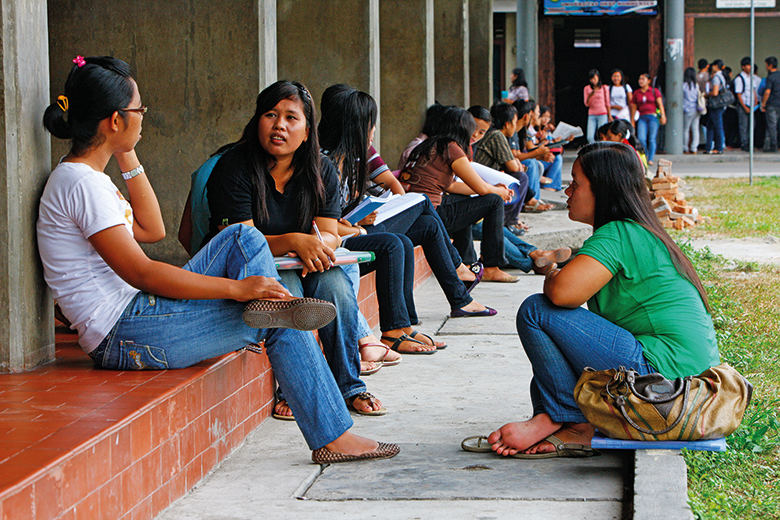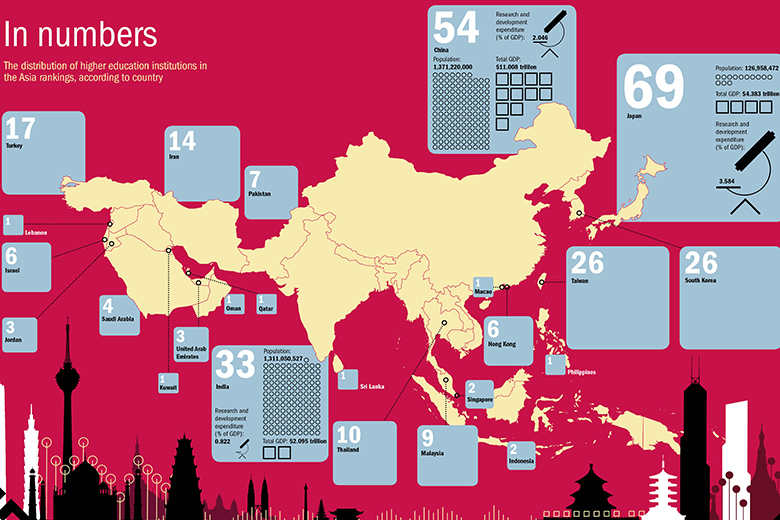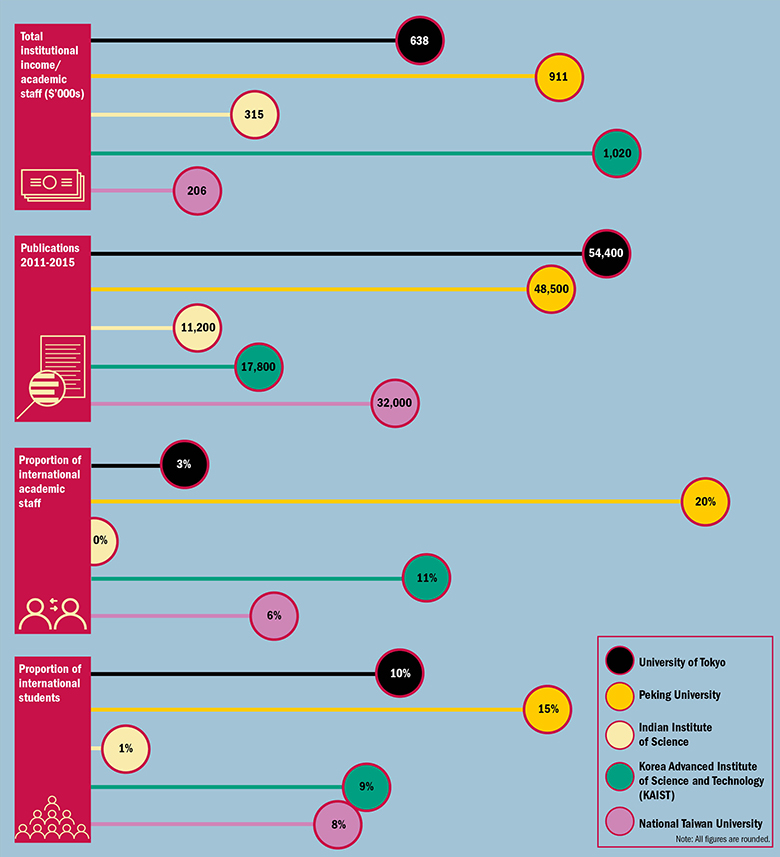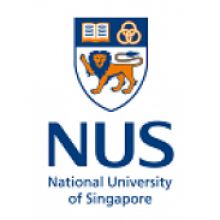Browse the full list of the top 300 institutions in this year’s rankings
The National University of Singapore is the top institution in the continent for the second year in a row, while Malaysia, Indonesia, Pakistan and Thailand are among the Asian nations that could become leading higher education hubs in future years, according to the Times Higher Education Asia University Rankings 2017.
The rankings, which have been expanded to include 300 universities, up from 200 institutions last year, suggest that these countries have the potential to follow in the footsteps of Asian higher education powerhouses such as China and South Korea.
Thailand is the most represented country in Southeast Asia, with 10 universities in total, led by Mahidol University in 97th place. King Mongkut’s Institute of Technology Ladkrabang, one of three new entries for the nation, has climbed into the top 200. It is particularly strong in terms of industry income, ranking among the top 30 when measured on this indicator alone.
- A diverse region rich with potential
- THE Japan University Ranking will show insularity must end
- What fuels university-industry partnerships?
- Read more about the best universities in Asia for students
Meanwhile, Indonesia now has two representatives, doubling its tally from last year; while Pakistan has seven, up from two, including two additional entries in the top 200.
But of the emerging university nations in Asia, the rankings results suggest that Malaysia has the greatest potential.
The country claims seven of the top 200 places, up from four last year, and features a total of nine institutions overall.
The University of Malaya is the nation’s new number one institution. It occupies 59th place overall despite taking part for only the first time this year. The data show that it has a particularly strong international outlook when compared with other leading universities in the continent; it ranks 20th when measured on this indicator alone.
Mohd Amin Jalaludin, vice-chancellor of the University of Malaya, said that international students now made up 18 per cent of the institution’s total enrolment, up from 5 per cent in 2000, and that about 20 per cent of its academics came from abroad.
- India’s upstarts are revolutionising higher education
- Hong Kong’s ties to mainland China do a power of good
- Availability of higher education by a country’s income
- Listen: Asia University Rankings results podcast
The university now offers programmes in English “to accommodate this major shift”, he said.
In addition, about 40 per cent of the university’s research papers are published with international collaborators, he said, adding that the university’s high-impact research programme, which ran from 2011 to 2016, had “transformed” the research culture among academics and postgraduate students.
Search for university jobs in Asia
According to Professor Jalaludin, Malaysia was “definitely on [its] way to becoming a leading higher education nation”, based on the number of “quality universities” and branch campuses of renowned international institutions in the country. He cautioned, however, that “there should be distinctions” between what smaller countries such as Malaysia can achieve compared with giants such as China.
“While we may not have the kind of scale [that China enjoys], we should be focusing on quality,” he said.
Overall, the most-represented nation in the rankings is Japan, with 69 institutions. However, the majority of Japan’s universities have lost ground in the rankings since last year, while rivals in China, Hong Kong and India have continued to rise.
The table is based on the same 13 performance indicators as THE’s World University Rankings, but these have been recalibrated to reflect the attributes of Asia’s universities.
Asia University Rankings 2017: top 10
| 2017 Asia rank | 2016 Asia rank | World University rank 2016-17 | University | Country |
| 1 | 1 | 24 | National University of Singapore | Singapore |
| 2 | =2 | 29 | Peking University | China |
| 3 | 5 | 35 | Tsinghua University | China |
| 4 | =2 | 54 | Nanyang Technological University | Singapore |
| 5 | 4 | =43 | University of Hong Kong | Hong Kong |
| 6 | 6 | 49 | Hong Kong University of Science and Technology | Hong Kong |
| 7 | 7 | 39 | University of Tokyo | Japan |
| 8 | 10 | =89 | Korea Advanced Institute of Science and Technology (KAIST) | South Korea |
| 9 | 9 | =72 | Seoul National University | South Korea |
| 10 | 8 | =104 | Pohang University of Science and Technology | South Korea |
Browse the full list of the top 300 institutions in this year’s rankings

Good conditions for take-off in Malaysia and Indonesia
Our expanded ranking provides detail on which nations might be next to challenge the region’s traditional higher education powerhouses
Dating back to 1905, the University of Malaya might not be considered old by world standards, but it was the first university established in Malaysia and is one of the oldest institutions in the Southeast Asian region.
According to its vice-chancellor, Mohd Amin Jalaludin, its history means that it has had time to “build up a strong reputation and brand name”, but a key element of its success is that it is “always willing to change and transform in accordance to time and needs”.
The institution is focusing on collaborations with industry, for example, which is already leading to stronger research output and teaching quality, says Jalaludin.
“This ability to adjust and adapt has made UM more competitive and relevant,” he explains.
The University of Malaya is one of several new entries in the Times Higher Education Asia University Rankings 2017, breaking into the list at 59th place.
The data show that it has a particularly strong international outlook when compared with other leading universities in the region; it ranks 20th when measured on this indicator alone.
Overall, this year’s Asia ranking is led by familiar names: the National University of Singapore (which was created from the original University of Malaya in 1959) is number one for the second year in a row, followed by the Beijing duo of Peking and Tsinghua universities. In fact, the top 10 consists of the same institutions as last year, albeit in a slightly different order.
View this year’s Asia University Rankings methodology in full
When considering national performances, the results are similarly predictable. Japan dominates with 69 universities in the newly expanded top 300 table, followed by mainland China with 54. India is for the first time the third most-represented nation, accounting for 33 universities – double the number in last year’s list.
But the expansion of the ranking to feature 300 universities, up from 200 last year, provides a glimpse of the countries that might follow in the footsteps of these powerhouses and become leading higher education nations in the years to come.
Take Malaysia. The country has nine universities in the ranking, up from four last year, including three new entries in the top 200. Alongside the University of Malaya in the top 60, Universiti Tunku Abdul Rahman (UTAR) joins the 111-120 band, while Universiti Teknologi Petronas is in the 141-150 cohort.
Simon Marginson, professor of international higher education and director of the Centre for Global Higher Education at the UCL Institute of Education, says that Malaysia is “within shouting distance of take-off” when it comes to higher education success, noting that the country has one of the world’s fastest growth rates in research paper outputs, albeit from a low base, and PhD training capacity has increased.
With a gross domestic product per capita (PPP, World Bank 2015) of $26,950 (£21,560), well above the world average of $15,673, Malaysia is also becoming a wealthy country, Marginson adds, but although it spends a healthy proportion of its money on higher education, “much of the resources go to subsidising participation by middle-class families who would participate regardless of the regime for tuition and student support”.
The country has also overemphasised applied research at the expense of basic research, he continues, despite the fact that there is not enough local research depth and trained talent to take on the application to commercial research. In addition, too many of the country’s PhD students have been sent abroad, which has held back the local infrastructure.
“To be blunt, Malaysia remained in a position of neocolonial dependency, vis-à-vis the UK and the US, long after it already had the resources to be building its own scientific capacity. This was a policy error of the long Mahathir [Mohamad] prime ministership,” says Marginson.
“All nations should send some of their PhD students abroad, but the balance between the overseas trained and locally trained is vital. Too much local training reduces the level of global knowledge in the national system. Too much international training means there is no national system.”

Claim a free copy of the Asia University Rankings 2017 digital supplement
Indonesia is another potential future higher education star.
The country has doubled its representation in the Asia ranking, with newcomer Bandung Institute of Technology (ITB) (201-250) joining the University of Indonesia (251+).
Kadarsah Suryadi, rector of Bandung Institute, says that the country’s large – and growing – youth population and pool of more than 4,300 universities provide a great opportunity for success.
But the quality of the institutions is “very diverse”, and university budgets are low, he says.
His institution, however, has benefited from being given the status of an “autonomous university” – one of just 11 in the country to have this title. This, he says, allows management to be “more agile and flexible” and to make faster decisions.
It has also helped the university to launch partnerships with industry and international universities and to increase funding from both business and research collaborations.
Marginson says that Indonesia is “the next Brazil”: it has the fourth largest population in the world, has exceptional resources, and is led by a secular Islamic state that “on the whole successfully holds a very diverse country together”, he explains.
“It is growing well in economic terms and undergoing accelerated modernisation as [rural inhabitants] move to the cities,” he adds.
But while there is a well-developed professional teaching culture, investment in research science has never been a “national priority”, he says.
Browse Times Higher Education’s full portfolio of university rankings
Elsewhere in Southeast Asia, Thailand “might be a sleeper”, Marginson says. It is the best-represented country in the region in the rankings with 10 universities, led by Mahidol University in 97th place.
“The country has a per capita GDP ($16,430 PPP, World Bank 2015) above the world average, there is a strong scholarly culture in some institutions and genuine research outputs, but it needs a committed ministry prepared to lift investment in scientific research capacity for a decade or more,” he says.
Moving to South Asia, Pakistan seems the most promising nation to follow India’s success.
Seven Pakistani institutions make the Asia top 300, including three in the top 200 (compared with two last year). Its leading institution, Quaid-i-azam University, is in the 121-130 band.
Keiko Miwa, practice manager for education in the South Asia region at the World Bank, says that the country’s major higher education reform began 15 years ago when it created the Higher Education Commission.
Since then, enrolment has risen significantly (from 280,000 students in 2002 to 1.3 million today), and 47 per cent of these are women (compared with 36 per cent 10 years ago), according to data from the World Bank.
But only about 10 per cent of the country’s university-age population go to university, which is much lower compared with other countries in the same region, Miwa says.
Last year, India joined the top 30 of the Asia rankings for the first time, with the Indian Institute of Science claiming joint 27th place. It holds on to that spot this year.
Could Pakistan improve on the same scale as other middle income countries?
“They have the vision and they are definitely trying. And it is important to sustain their reforms,” says Miwa.
Country by country: vital statistics for each nation ranked
For Marginson, Pakistan’s main challenge is its lack of resources. Its low GDP per capita ($5,011 PPP, World Bank 2015) means that it “cannot invest in science on a world competitive scale, sufficient to sustain national research capacity across the board”, he says.
“Most of the Pakistan elite will continue to go offshore for higher education, in the inherited neocolonial fashion, for some time to come yet,” he predicts.
Richard Robison, emeritus professor in the Asia Research Centre at Murdoch University, is also “pessimistic” about the country’s immediate prospects.
“I don’t expect that we’re going to see many universities outside the Asian countries that are already making an impact climbing up in these rankings,” he says.
Referring to the Southeast Asian region, he says that the main problem lies with governments, rather than universities, claiming that the states “do not have the capacity or the organisation” to build their economies in the way that governments in north-east Asia and Singapore have done.
Last year, Chandran Nair, founder and chief executive of Global Institute for Tomorrow, a pan-Asian thinktank, suggested that the Association of Southeast Asian Nations (Asean) could launch its own university or research institute with a physical campus, with the aim of improving academic rigour in the region.
But H. E. Vongthep Arthakaivalvatee, deputy secretary general of Asean, says that the organisation is instead looking at “leveraging what we have”, with a focus on promoting higher education in the region as a whole.
He lists the four ingredients that will be key to success: credit transfer between the member countries, improved quality assurance, a qualifications framework and the promotion of “intra-Asean” student mobility.
He adds that an Erasmus-type scheme for the region, in which students from one country take a semester at a university in another part of the region, could work well.
Top performers
What makes the highest-performing institution in a country stand out?
“We want to forge a process of collaboration,” he says.
Indeed, collaboration is a vital element of success in many of the leading universities in the Asia ranking.
Joseph J. Y. Sung is vice-chancellor of the Chinese University of Hong Kong (CUHK), which climbed two places to 11th in the list and joined the world top 100 for the first time last year. He attributes part of its improvement to joining the Worldwide Universities Network, a research alliance of 21 universities across five continents, in 2011.
Each university contributes funding so the group can collaborate on research, says Sung, who is now the chair of the network.
“All this enhances our international appearance and explains maybe why our international reputation has gone up,” he adds.
The university also works closely with mainland China. It has joint courses and joint research centres with Shanghai Jiao Tong and Tsinghua universities, as well as a research institute within the mainland, in order to access China’s research funding.
“We can provide more internationally renowned researchers while they have more funding to support ongoing research,” he explains.
Increased collaboration within the continent and with the wider global academic community will help more Asian nations to improve their higher education systems in the years to come.
Register to continue
Why register?
- Registration is free and only takes a moment
- Once registered, you can read 3 articles a month
- Sign up for our newsletter
Subscribe
Or subscribe for unlimited access to:
- Unlimited access to news, views, insights & reviews
- Digital editions
- Digital access to THE’s university and college rankings analysis
Already registered or a current subscriber? Login














